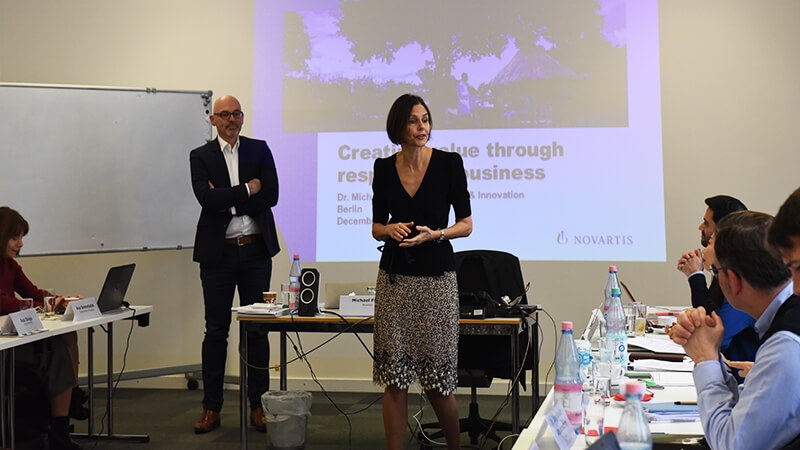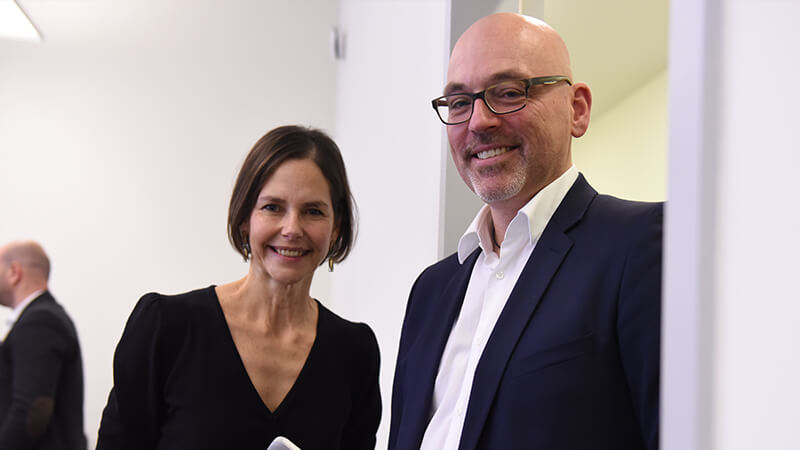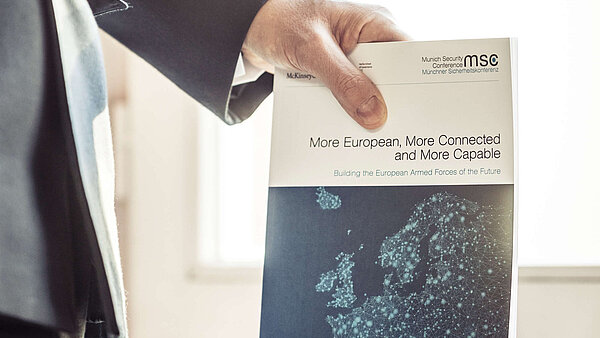
Johanna Mair guides EMPA students on a quest for the secret to creating impact.
“Is innovation the holy grail? What is social innovation?” asks Johanna Mair at the start of a three-day Executive MPA seminar, convening professionals from government, business and social sectors for a marathon brainstorming session – an innovation lab of sorts, on innovation itself. “There are no set-in-stone theories for social innovation,” the Professor for Organization, Strategy and Leadership at the Hertie School tells the group. “Your participation is part of knowledge creation.”
Via guest lectures, workshops and discussions, the seminar aims to define social innovation, explore what constitutes its success, and understand how participants can adopt and adapt its tools for their own purposes in practice. Evolving from ideas such as economist Joseph Schumpeter’s theory of “creative destruction” and a number other 19th and 20th century social scientists, social innovation is seen as a way of establishing new solutions for society’s “grand challenges”.
These are problems like access to healthcare and education, the effects of climate change or extreme poverty. Some well-known examples of social innovation are micro-finance, which offers affordable small business loans to people usually rejected by banks – often in developing economies; or emissions trading, which aims to limit air pollution through a market in which companies trade emissions allowances.
With very different purposes in mind, the students in Mair’s course embark on what she dubs a “learning journey”. “You come with your own backpack of experience,” she tells them. A round of introductions reveals the breadth and depth of this experience: a corporate fundraiser for UNICEF; a Danish healthcare worker; a corporate social responsibility manager from a big South Korean technology company, civil servants from Georgia, Denmark, Germany, Colombia and Romania, representatives of a UK family investment fund, to name a few. Mid-career students travel to Berlin from around world to attend such intensive seminars, working towards an Executive Master in Public Administration (Exective MPA) or one of three Executive Certificates. The school also offers open enrolment for some classes, like this one, for professionals not in the degree programme.
Taught together with Hertie School adjunct Christian Seelos, the seminar encourages students to take a critical stance on the appropriate use of social innovation in organisations. Students discuss case studies, such as the business model used by sustainable healthcare non-profit One World Health to produce drugs for neglected diseases. In workshops, they reflect on how others have tackled “innovation pathologies”, and what it means for their own organisations. Guest speakers, such as Michael Fürst, head of Corporate Social Responsibility at the pharmaceutical company Novartis AG, and a casual fireside chat with social entrepreneur Anne Kjaer Riechert, who started ReDI School of Digital Integration for helping asylum seekers in Germany, give the students a chance to pose questions to experienced practitioners.

“It’s really a mix of state of the art practice that we expose them to – a deeper knowledge we have generated by working over the years with organisations that carry out social innovation – and a number of diagnostics, such as the innovation pathologies, that we provide in this particular course,” says Mair. She and Seelos co-authored the award-winning 2017 book, Innovation and Scaling for Impact: How Effective Social Enterprises Do It (Stanford University Press). The book helps non-profits decide when and where innovation is appropriate. Mair also brings a wealth of experience from the business world, having worked in finance prior to her academic career, as well as from on-the-ground fieldwork, such as her decade-long research on “scaffolding”, looking at how an organisation in India tackled inequality in villages by improving access to hygiene facilities.
“What is desperately needed is not more solutions, not more tools, but to really take the effort to think things through and then make informed decisions,” Mair tells the class. Equally as impassioned about teaching as she is about learning from these mid-career professionals, Mair moves around the room, pitching questions like a trainer on the court and coaching the students to hit back: “How do we define success – short-term, long-term?”; “Is it an effective way of addressing a problem or an efficient way?”; “Do we spend time evaluating what went wrong?”
Unpacking experiences
“Let’s start with the question of impact,” she says. “Impact is really the thing we are all after. The problem is – how can we demonstrate impact? Is it about getting through one drug – or is it about system change?” Thursday morning starts out with a case study on a pharmaceutical introduction in a developing country initiated by Victoria Hale, founder of the Institute of One World Health. Students explored the obstacles, such as availability, accessibility and affordability of the drug, and portability of the concept for other markets.
“Should we think of innovation as a process or an outcome – is the social impact a bond – the tool – or is it the process to get there – bringing investors, social enterprise, governments together – is that the innovation?” Mair asks.
Students offer answers and raise questions based on their own experiences. Mair unpacks what they put on the table, giving it context and playing the nimble and receptive devil’s advocate. One student proposes that grand challenges require big personalities, like Victoria Hale: “You need people who are enthusiastic enough and charismatic enough – social innovators who enable others to be innovative in the social sector. There are always one or two people to start with who are able and willing to take the first step,” he says.
“But they alone cannot – and should not – carry all the weight,” counters Mair. “If I am a little bit critical of the field of practice, then it is that we overdid it with heroizing individuals – it is very important we do that, because we need a face, we need a role model in a way, but we put too much on the shoulders of these people.”
Another participant who worked in development in Africa said he had seen a big push for social innovation, but also a lot of failed social innovation when governments were involved. “Shouldn’t social innovation just be left to the private sector? I know it’s not that straightforward, but markets have to respond and there’s more pressure…I worked with government cultural institutes. It sort of did some good, but failed in the long run. If I ask why, it was due to politics and special interests.”
Mair: “Should we think about social innovation as government failure?” She points out that the Danish government, for example, sought partners to find a cost effective way to provide social services. “That’s not necessarily a government failure.”
The metrics of impact
After the warm-ups, Michael Fürst of Novartis joins the course. Fürst lays out the business model for expanding access to medication in impoverished regions and talks in depth about developing the company’s inclusive business, Novartis Access.
“We want to deploy business solutions in the future, because business allows us to scale and replicate – charity will not do this on a global scale,” he says. He hits on the thorny topic of performance measurement, how the company established a set of indicators to evaluate the success of their social innovation – both in a business and a social sense. Novartis has become a leader in establishing performance metrics for social innovation, he says.
Mair contextualises the need for metrics: social businesses working on specific problems usually know what defines their success, but the current “race to embrace” performance indicators is being fuelled by interests of funders, including public funders who use taxpayer money, or so-called impact investors. “That explains why we are so driven to measure impact,” she says.
On Friday, Christan Seelos takes modelling a step further in a workshop exploring how two organisations create a joint business model to tackle a social problem. The students focus on Waste Concern, a waste management and recycling company in Bangladesh that teams up with an agriculture business to clean up streets, recycle organic matter and create jobs. “The solution is aligned with the strategic objectives of both organisations,” he says.
Saturday’s sessions are devoted to diagnosing “innovation pathologies” - using instruments to understand productivity and effectiveness - and to taking a look at how to influence policy. At the end of three days, the students examine the relevance of what they’ve learned for their own work. “It was very useful for finding convincing and constructive ways to bring new ideas upstream in my organisation,” said the participant from Unicef.
Whether the ideas are new or old, students have had a long think about how to create an “enabling ecosystem,” as Mair puts it. In the end, their conclusions about social innovation might inch this field a little further along in its evolution from the legacy of Schumpeter. “Perhaps we even put too much emphasis on innovation,” says Mair. “After all it’s the hard work of doing things, the routine work, the twisting and tweaking that creates more impact than constantly disrupting.”


